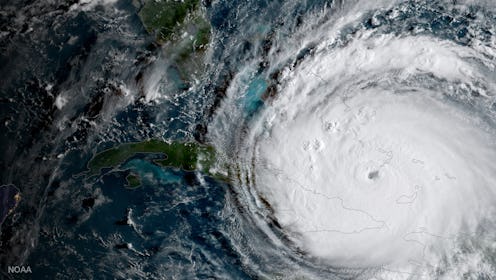News
This Video Of Hurricane Irma Battering Cuba Will Absolutely Petrify You

Hurricane Irma swept through Cuba Friday night and Saturday morning, directly hitting the island's northern coast. At least 21 people have already been reported dead as Irma hit Cuba, and it continues to hover near the island as it moves toward mainland Florida. Video footage from Cuba as Hurricane Irma razed through the island shows extreme winds, approximately 155 mph, and flooding of eight to 10 feet in the area.
The then-Category 5 hurricane left destruction in its path through Cuba and is expected to continue to cause dangerous winds and rain. Video from the storm's approach shows trees bending from the winds and the ocean breaking through barriers in huge waves, crashing over the shore toward roads and structures.
Direct damage from the storm destroyed homes, many of which are single-story structures. Reports say the area was not prepared for a direct hit of this magnitude. Witnesses describe the rain as blinding, and power has been cut off as a result. Major towns are completely flooded, including the coastal resort town of Caibarién.
Local reports say Irma is the first Category 5 storm to hit the region in 85 years. They core of the storm is expected to remain on the northern coast of Cuba throughout the day Saturday before moving north.
More damage may still be yet to come for Cuba as yet another storm, Hurricane Jose, moves north. Hurricane Jose is a Category 4 storm that is now moving westward toward the Leeward Islands. Jose is expected to bring 145 mph winds.
Tourists in Cuba were urged to evacuate as the storm moved closer to reaching landfall. At least 10,000 tourists were evacuated from Cuba as of Saturday morning.
Though Irma was downgraded to a Category 4 storm after being slowed by its move along the coast of Cuba, officials say it may regain strength as it barrels toward the southern tip of Florida. Over 7 million people have now been asked to evacuate. The eye of the storm will hit the Florida keys in the coming hours, according to the latest predictions.
The U.S. National Hurricane Center said by Sunday morning, Florida will begin feeling the full force of the hurricane. As of Saturday morning, the southern coast of Florida experienced some of the tail effects of the hurricane, the center of which remained primarily near Cuba. Irma is regarded as one of the most powerful storms of the century.
In anticipation of its hit in Florida, evacuations are widespread, causing congested highways and gasoline shortages. Reports say at least one-third of Florida metropolitan gas stations were out of gasoline as of Friday.
Latest reports are still unsure whether Irma will hit Cuba's capital of Havana or continue moving north, avoiding the city directly. The Defense Ministry issued an alarm for three Cuba provinces: La Habana, Mayabeque, and Artemisa. The U.S. National Hurricane Center also said heavy rain in Cuba may cause mudslides along the north coast, which has already been cut off from any transportation or source of power in some areas, including the small town of Yateras.
Located in the southern corner of Cuba, the Guantanamo Bay Naval Station reports it has not been severely impacted by the storm.
The small islands of the northern Caribbean region were also devastated by the storm, and an estimated 24 have died as a result. The region is now preparing for a second storm, Hurricane Jose, which is expected to reach the Caribbean by Saturday. Seventy percent of St. Maarten homes, which are also in the path of oncoming Hurricane Jose, were damaged.
Hurricane Irma will hit just weeks after Hurricane Harvey hit Texas, killing 60 people.